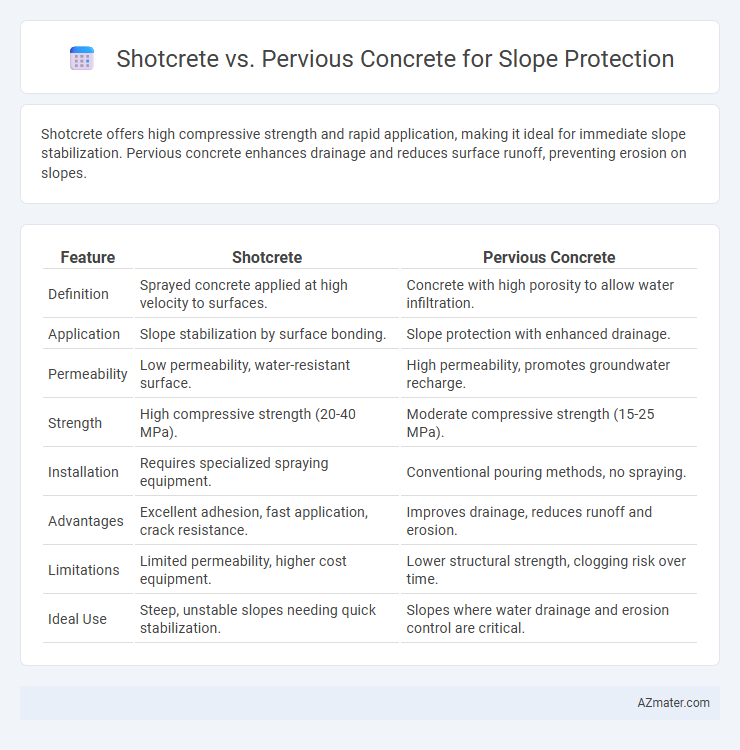Shotcrete offers high compressive strength and rapid application, making it ideal for immediate slope stabilization. Pervious concrete enhances drainage and reduces surface runoff, preventing erosion on slopes.
Table of Comparison
| Feature | Shotcrete | Pervious Concrete |
|---|---|---|
| Definition | Sprayed concrete applied at high velocity to surfaces. | Concrete with high porosity to allow water infiltration. |
| Application | Slope stabilization by surface bonding. | Slope protection with enhanced drainage. |
| Permeability | Low permeability, water-resistant surface. | High permeability, promotes groundwater recharge. |
| Strength | High compressive strength (20-40 MPa). | Moderate compressive strength (15-25 MPa). |
| Installation | Requires specialized spraying equipment. | Conventional pouring methods, no spraying. |
| Advantages | Excellent adhesion, fast application, crack resistance. | Improves drainage, reduces runoff and erosion. |
| Limitations | Limited permeability, higher cost equipment. | Lower structural strength, clogging risk over time. |
| Ideal Use | Steep, unstable slopes needing quick stabilization. | Slopes where water drainage and erosion control are critical. |
Introduction to Slope Protection Methods
Slope protection methods are critical for preventing soil erosion and maintaining stability in construction and landscaping projects. Shotcrete provides a strong, durable layer by spraying concrete onto slopes, ensuring immediate surface reinforcement, while pervious concrete offers enhanced drainage by allowing water to pass through its porous structure, reducing runoff and hydrostatic pressure. Choosing between shotcrete and pervious concrete depends on site-specific factors such as slope gradient, soil type, and water management requirements.
Understanding Shotcrete: Definition and Applications
Shotcrete is a method of applying pneumatically projected concrete or mortar onto surfaces, often used for slope protection due to its high adhesion and structural reinforcement capabilities. It provides immediate support to unstable slopes by forming a dense, durable layer that resists erosion and weathering. Common applications include retaining walls, tunnel linings, and slope stabilization in both civil engineering and mining projects.
Pervious Concrete Explained: Key Features and Uses
Pervious concrete is a highly porous material designed to allow water infiltration, making it ideal for slope protection by reducing surface runoff and preventing erosion. Its key features include high permeability, reduced runoff, and enhanced groundwater recharge, which help maintain slope stability while managing stormwater effectively. Common uses of pervious concrete in slope protection include drainage layers, retaining wall backfill, and erosion control on embankments, where water flow needs to be regulated without compromising soil integrity.
Material Properties Comparison: Shotcrete vs Pervious Concrete
Shotcrete exhibits high compressive strength typically ranging from 20 to 40 MPa, making it ideal for immediate slope stabilization and erosion control, while pervious concrete offers lower strength, generally between 10 and 20 MPa, but excels in permeability due to its porous structure that facilitates water drainage. The dense, impermeable matrix of shotcrete provides robust resistance to weathering and abrasion, whereas pervious concrete's interconnected void system reduces surface runoff and promotes groundwater recharge, enhancing slope sustainability. Shotcrete requires skilled application with pneumatic projection that ensures adherence and compaction, contrasting with pervious concrete's conventional placing and curing methods aligned with environmental water management goals.
Installation Techniques and Process Differences
Shotcrete involves pneumatically applying a wet or dry mix of concrete onto slopes, allowing for rapid placement and strong adhesion to irregular surfaces without formwork, making it ideal for steep or difficult terrain. Pervious concrete, installed by placing and compacting a porous mixture on slopes, requires careful control of water content and compaction to maintain permeability and prevent runoff, often involving traditional batching and surface finishing methods. The primary process difference lies in shotcrete's spray application enabling quick setting and structural reinforcement, whereas pervious concrete demands precise mixture consistency and compaction to achieve effective drainage and slope stabilization.
Performance in Erosion Control and Drainage
Shotcrete provides superior erosion control on slopes due to its dense, impermeable surface that effectively resists water runoff and soil displacement. Pervious concrete excels in drainage performance by allowing water to infiltrate through its porous structure, reducing surface runoff and promoting groundwater recharge. Combining shotcrete's erosion resistance with pervious concrete's drainage capabilities can optimize slope protection in challenging environments.
Environmental Impact and Sustainability Analysis
Shotcrete offers high durability and rapid application on slopes but relies heavily on cement, contributing to significant carbon emissions and resource depletion. Pervious concrete enhances environmental sustainability by allowing natural water infiltration, reducing runoff, and promoting groundwater recharge, which helps mitigate erosion and preserves local ecosystems. Using pervious concrete supports sustainable slope protection by balancing structural integrity with eco-friendly water management practices.
Cost Considerations and Project Budgets
Shotcrete offers a cost-effective solution for slope protection with lower initial application expenses and quicker installation compared to pervious concrete. Pervious concrete, while more expensive upfront due to material costs and specialized labor, provides long-term savings through enhanced water drainage and reduced erosion control maintenance. Project budgets should account for shotcrete's suitability in immediate stabilization versus pervious concrete's benefits in sustainable drainage and lifecycle cost efficiency.
Maintenance and Longevity: Long-Term Evaluation
Shotcrete offers superior durability with its dense, impermeable matrix that resists erosion and reduces maintenance frequency on slopes exposed to high rainfall or freeze-thaw cycles. Pervious concrete enhances drainage, preventing water buildup and minimizing hydrostatic pressure, but requires regular cleaning to maintain permeability and avoid clogging, impacting long-term performance. Both materials provide effective slope protection, though shotcrete's robust structural integrity typically ensures longer lifespan and lower maintenance costs over decades in harsh environments.
Choosing the Right Solution: Factors to Consider
When selecting between shotcrete and pervious concrete for slope protection, consider factors such as soil stability, drainage requirements, and environmental impact. Shotcrete offers superior structural strength and erosion control on steep or unstable slopes, while pervious concrete facilitates effective water infiltration, reducing surface runoff and promoting groundwater recharge. Evaluating site-specific conditions, including slope gradient, precipitation patterns, and vegetation, ensures optimal slope stabilization and long-term durability.

Infographic: Shotcrete vs Pervious Concrete for Slope Protection
 azmater.com
azmater.com